#Printing an array in java
Explore tagged Tumblr posts
Text
Printing an array in java with example
In this article, we will discuss printing an array in java using different methods like using loop, without loop, 2d array, and array in reverse with source code and output of that. #1. Printing an Array in Java using for loop A. Explanation of the source code The code snippet below demonstrates how to print an array in Java using a for loop. The for loop iterates through the elements of the…
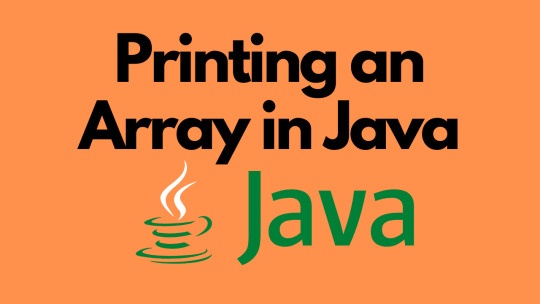
View On WordPress
#Printing a 2D Array in Java#Printing a Byte Array in Java#Printing an array#Printing an array in java#printing an Array in Java using for loop#Printing an Array in Java without a Loop#Printing an Array in Reverse Order in Java#Printing an ArrayList in Java
0 notes
Text

Example of Printing Java Array using the "for-each" Loop
Let us see an example of printing Java array using the "for-each" loop
#java#programming#javaprogramming#code#coding#engineering#software#softwaredevelopment#array#javaarray#arrayinjava#education#technology#online
2 notes
·
View notes
Text
10+ Tips for Acing Basic Coding Interviews

Coding interviews are a key step toward landing a technical role in the tech industry. While intimidating at first, with the right preparation and mindset, you can ace even the toughest basic coding interviews. Whether you're a recent graduate or a professional switching careers, these tips will help you stand out.
1. Understand the Fundamentals
Before diving into complex problems, ensure your basics are solid. Familiarize yourself with:https://internshipgate.com
Data structures like arrays, linked lists, stacks, and queues.
Basic algorithms such as sorting, searching, and recursion.
Key concepts like time and space complexity.
2. Practice Common Interview Questions
Many interview questions follow recurring patterns. Websites like LeetCode, HackerRank, and CodeSignal provide a treasure trove of commonly asked questions. Focus on problems involving:
Arrays and strings.
Binary trees and graphs.
Dynamic programming.
3. Master a Programming Language
Proficiency in one programming language is crucial. Python, Java, and C++ are popular choices. Stick to one language and become familiar with its syntax, libraries, and debugging tools.
4. Develop Problem-Solving Strategies
Approach each problem methodically:
Understand the problem – Clarify any doubts.
Plan a solution – Use pseudocode to outline your approach.
Write clean code – Focus on readability and modularity.
Test your solution – Check for edge cases and optimize if needed.
5. Practice Whiteboard Coding
Coding interviews often involve whiteboard sessions. Practice solving problems on a physical or virtual whiteboard to simulate the interview environment. Focus on communicating your thought process clearly while coding.
6. Brush Up on Behavioral Questions
In addition to technical questions, interviews often include behavioral ones. Prepare answers for questions like:
"Tell me about a challenging project and how you handled it."
"How do you approach learning a new technology?"
Use the STAR method (Situation, Task, Action, Result) for structured responses.
7. Learn Basic Debugging Techniques
Knowing how to debug efficiently is essential. Familiarize yourself with tools like:
Print statements.
Debugger features in IDEs.
Unit tests to validate code functionality.
8. Study Real-World Applications
Understand how coding concepts are applied in real-world scenarios. For instance, know how hash tables are used in caching or how graphs are utilized in navigation systems.
9. Time Yourself During Practice
Most coding interviews have time constraints. Practice solving problems under timed conditions to build speed and accuracy. This will help you manage stress and perform well during the actual interview.
10. Seek Mock Interviews
Mock interviews simulate real interview experiences. Practice with friends, mentors, or on platforms like Pramp and Interviewing.io. Feedback from these sessions can help you identify and address weaknesses.
11. Stay Calm and Confident
Interviewers often value your approach to problem-solving more than the final answer. If you’re stuck, explain your thought process and ask clarifying questions. Confidence and composure go a long way.
12. Review After Every Interview
After each interview, reflect on what went well and where you struggled. Use this feedback to fine-tune your preparation for the next opportunity.
Conclusion
Acing coding interviews requires a mix of technical expertise, problem-solving skills, and effective communication. With consistent practice and a clear strategy, you can approach your next interview with confidence and skill. Good luck!https://internshipgate.com
#career#internship#coding#virtualinternship#internshipgate#internship in india#education#programming#job opportunities
0 notes
Text
Winter Camps in Dubai: A Perfect Blend of Fun and Learning with Brainy n Bright
As the winter season approaches, parents in Dubai are always on the lookout for engaging activities to keep their children entertained and productive during the holidays. Winter camps provide a fantastic opportunity to combine fun with learning, and Brainy n Bright’s winter camps stand out as an exceptional choice for young learners. Designed to inspire creativity, foster innovation, and develop critical skills, these camps are tailored for children aged 6 to 16 and are held in a safe, stimulating environment.
In this blog, we’ll explore the many aspects of Brainy n Bright’s winter camps in Dubai, from their unique features and activities to the numerous benefits they offer for kids and parents alike.

Why Choose a Winter Camp?
Winter camps are more than just a way to keep kids busy during the holiday season. They offer a wide range of benefits, including:
Skill Development
Children learn new skills that enhance their creativity, problem-solving abilities, and critical thinking.
Structured Fun
Kids participate in well-organized activities that ensure they are engaged and entertained throughout the day.
Social Interaction
Winter camps bring children together, helping them develop teamwork and communication skills while making new friends.
Screen-Free Learning
Camps encourage active, hands-on experiences that balance education with physical and mental engagement.
Brainy n Bright: A Leader in Winter Camps
Brainy n Bright stands out for its commitment to excellence in STEM education and creative learning. Their winter camps in Abu Dhabi are tailored for children aged 6 to 16, ensuring every participant enjoys a unique and enriching experience.
Key Features of Brainy n Bright Winter Camps
Expert Instructors: Led by experienced educators who specialize in STEM fields.
Interactive Learning: Emphasis on hands-on projects and practical applications.
Diverse Activities: Covering robotics, AI, game development, drone technology, and more.
Safe Environment: Camps are held in secure, child-friendly facilities.
Flexible Schedules: Options for half-day and full-day programs to accommodate family needs.
Exciting Activities Offered
Brainy n Bright’s winter camps provide an array of activities that ignite curiosity and inspire innovation:
Robotics and AI
Build and program robots to perform specific tasks.
Learn the basics of Artificial Intelligence and machine learning.
Explore real-world applications of robotics in industries like healthcare and transportation.
Game Development
Create video games using beginner-friendly coding platforms.
Design characters, levels, and gameplay mechanics.
Develop logic and coding skills in a fun, interactive environment.
Drone Technology
Discover the science behind drones.
Learn how to operate and program drones for various tasks.
Engage in drone racing and obstacle challenges.
3D Printing and Design
Understand the basics of 3D modeling.
Create prototypes and print them using state-of-the-art 3D printers.
Explore applications in engineering, architecture, and design.
Creative Arts and STEM Integration
Combine art with technology to create digital illustrations and animations.
Learn about the intersection of STEM and the arts.
Participate in collaborative projects that blend science, technology, and creativity.
Coding Bootcamp
Develop coding skills using platforms like Python, Scratch, and Java.
Create apps and simple programs.
Build a strong foundation in programming concepts.
Benefits of Attending Brainy n Bright Winter Camps
Parents and children alike find immense value in Brainy n Bright’s winter programs. Here’s why:
Comprehensive Learning Experience
From STEM education to creative arts, the camps offer a balanced approach to learning, ensuring children develop both technical and soft skills.
Age-Appropriate Programs
Activities are carefully designed to match the developmental needs of different age groups, ensuring each child enjoys a personalized learning experience.
Innovative Curriculum
Brainy n Bright continuously updates its curriculum to reflect the latest trends in technology and education.
Boosts Confidence
By mastering new skills and completing projects, children gain a sense of accomplishment that boosts their self-esteem.
Networking Opportunities
Kids meet like-minded peers who share their interests, fostering friendships and collaboration.
How to Enroll
Enrolling your child in Brainy n Bright’s winter camps is simple:
Visit the Website: Explore the details and schedules at Brainy n Bright Winter Camps.
Register Online: Complete the registration process and secure your child’s spot.
Prepare for Fun: Receive a checklist of items your child will need for their camp experience.
Why Brainy n Bright?
Global Recognition
Brainy n Bright is internationally acclaimed for its contributions to STEM education, making it a trusted choice for parents.
Proven Track Record
With years of experience and countless success stories, Brainy n Bright has established itself as a leader in educational innovation.
Inclusive Environment
The institute welcomes children from diverse backgrounds, fostering an inclusive and supportive learning atmosphere.
Focus on Real-World Applications
By emphasizing practical projects, Brainy n Bright ensures children learn skills that have real-world relevance.
Conclusion
Winter camps at Brainy n Bright in Abu Dhabi are the perfect blend of fun, creativity, and learning. Whether your child is a budding engineer, an aspiring artist, or simply curious about technology, these camps provide an unforgettable experience that shapes their future.
Don’t miss this opportunity to invest in your child’s growth and development. Enroll today and let them embark on a winter adventure that sparks innovation and discovery.
#python programming for kids#summer camps in dubai#scratch coding in abu dhabi#robotics for kids#artificial intelligence course in dubai#artificial intelligence course in abu dhabi#artificial intelligence course for kids#app development course#winter camps in dubai#best robotics courses
1 note
·
View note
Text
Real-Life Projects to Practice Your Java Skills

Java is one of those programming languages that are extremely versatile and highly powerful, which are in great demand in different parts of the globe for web development, software applications, mobile application development, and many more. Building real-life projects is the best way to reaffirm your Java skills as you get a hang of how theoretical concepts work in practical scenarios. You're also prepared to face real-world coding challenges that's going to take you higher. If you need to find out about Java training in Coimbatore so that you can develop proper coding skills, it is a must that you target institutes only which will provide you hands-on experience with real-life projects. With this kind of Java training in Coimbatore, you are sure to get both theoretical knowledge and project-based skills making you ready for jobs.
In this blog, we will explore a few real-world projects that should make you better at Java-the simple little projects for beginning jobs to complex applications. Having completed these projects, you will not only have improved your knowledge of Java but also gained invaluable experience that will distinguish you in the market.
Real-Life Projects Matter in Java It is in practice that one masters Java. While theory would be of immense importance, it is only when implemented that one finds magic as the understanding becomes stronger. Projects help you understand how Java's OOP principles, error handling and other features work. Doing so will give you strength and problem-solving abilities to support a real job environment.
Here are a few project ideas to get you started on your Java programming.
Beginner-Level Projects Beginner projects have helped many students at the onset of their journey in Java or after a course. Beginner projects are easy to implement and impactful for understanding the basics of Java.
To-Do List Application The most popular beginner project is a To-Do List application. This project works on the core concepts of Java, such as data storage, arrays, or lists, and even handling user input.
Project Features:
Method to add, update, delete and display a tasks. Make use command line or simple GUI for user interaction Develop basic menu to navigate the options Skills Achieved
Work with lists or arrays to store tasks Practice all CRUD operations i.e, create, read, update, delete Manage user input and print output accordingly This project will give you good hold on basic Java syntax, control structures and simple data handling.
Simple Calculator A calculator is an app as straightforward as it comes, so let's get cozy with control flow and basic arithmetic operations in Java.
Project Features:
Add, subtract, multiply and divide Take input from the user regarding numbers and operations Handle cases when the user tries to divide by zero Skills UsedUsing conditionals and loops
Taking user input and displaying output Exceptional error cases Building a calculator will delve you deeper into how Java handles its arithmetic operations and basic logical flows.
Unit Converter A unit converter will convert a unit from one type to another, for example, kilometers to miles or kilograms to pounds or Celsius to Fahrenheit.
Project Features:
Perform conversions of various types; for example, length, weight, temperature, etc. Should be able to provide a user interface to select the type of conversion and also accept input values. The output should clearly show the result of conversion. Skills Developed
How to work with switch statements or if-else conditions How to format and output your answer correctly Basic user interface handling in a console or simple GUI Intermediate-Level Projects Once you have some experience from developing some beginner projects, you can look to move on to intermediate projects. These use the advanced concepts of Java, such as OOP, collections, and exception handling.
Library Management System A Library Management System may track books, may involve user management, and may monitor check-ins and check-outs. Project Features Add, update, and delete book records. Register and administer user accounts. Implement borrowing and return features with due dates. Skills Developed:
Object-Oriented Programming: designing classes for books, users, and transactions. Utilize Java Collections ArrayList or HashMap in storing record. Exception handling related to user input and file management. This project will give you outstanding understanding of OOP and real-world Java application scenarios that is critical to advance in the field. 5. Banking Application A banking application illustrates very basic banking operations like opening an account, balance inquiry, deposit, and withdrawal. Project Features:
Create accounts and manage user profiles. Implement transactions including deposits, withdrawals, and balance check. Provide login facility to allow users to access only with proper credentials. Skills Developed:
Works on OOP by making classes for accounts and transactions File handling for information about the users Error handling when input data is wrong or a transaction could not be processed With a banking application you can play out how financial applications may work in the real world and get hand-on feel for data handling capabilities in Java.
Projects at Advanced Level Advanced Projects: These projects are for learners who have a grasp of the core features of Java and are equipped to handle more complex pieces of work.
E-commerce Platform Building a basic e-commerce platform is quite rewarding. This project involves developing an online store wherein users can browse through products, add items to their cart, and make orders.
Project Features:
Product listing with details such as price, description, and image. Shopping Cart functionality. Checkout system with order confirmation. Skills Gained:
JDBC connectivity in Java for database connectivity Implementation of OOP concepts on the class product, user, and order Handling complex data structures related to orders and inventory This project will effectively show your mastery of the knowledge of Java while working on real-time applications in developing a web-based application, which will be profitable to go for roles interested in gaining total knowledge about full-stack development.
Chat Application A real-time chat application can depict the most popular messaging application and shows the practical experience with Java networking.
Project Features:
Real time messaging to users User login and profile Storage and retrieval of messages Skills Achieved:
Implementing a network between users using Java-sockets Multithreading for the clients which take care of multiple users at the same Data persistence- Store history of the messages A Chat application project will ensure your networking in Java and its multithreading, which are important facets in developing applications in real time.
Hospital Management A hospital management system shall simulate the management of patient's records, appointments, and doctor's schedules.
Project Features:
Patient sign-up and record handling Appointment booking and doctor assignment Tracking of patient history and billing information. Abilities Acquired: Advanced OOP design with many interacting classes Data handling by Java's Collections Framework Development of an well-structured, user-friendly interface This project is ideal for those interested in knowing how Java could be applied to health care and have rigorous practice at handling complex data. Key Technologies that Will be Applied These projects can be made even more powerful through the use of some of the following technologies and tools:
JavaFX - Developing rich GUI applications with a modern GUI. JDBC (Java Database Connectivity) - Connectivity is very important to the database for applications that deal with the storage of data. JUnit: This is used for unit testing and maintaining code quality. Git: This is done in real development with version control. Maven or Gradle - For project management and dependencies building. Advantages of the Experience on Real-Life Project There are many advantages you get from real-life projects: Understanding in Practice: Projects will make you understand how different features in Java, say multithreading, networking, or some concepts of OOP can be implemented for practical issues. Portfolio: These projects will give an opportunity to display them before potential employers in which they will enable them to appreciate your practical knowledge in Java. Better Problem Solving Ability: Preparing for real-life issues will equip you with experience in solving real-life, unknown problems in your projects. Relevance to the Industry: Current projects in the industry ensure that you stay updated with industry standards as a software aspirant. If you are looking for extensive training in Java in Coimbatore and wish to develop projects on real-time problems that are challenging yet rewarding, then finding the Best Software Training Institute in Coimbatore with Placement is the key. The secret behind a good training institute is not only that it teaches you theoretical knowledge but also gives you hands-on experience with real-life projects which may change the course of your career. There is no better way to learn and hone the skills other than doing actual projects with Java - building real-life applications such as calculators, to-do lists, complex e-commerce platforms, chat applications, and any others, each of which will teach you some valuable lessons and expose you to real-world coding.
Our Java training at Coimbatore at Xplore It Corp will ensure all hands-on projects help you gear up for real-life applications. These projects, along with expert guidance, will give you that competitive edge in the job market. You'll not only get to solidify your Java knowledge, but you'll just keep demonstrating practical coding abilities that will make you an ideal candidate for any Java-based role.
0 notes
Text
Integrate VeryUtils jPDFKit Command Line Software into your document workflows
Integrate VeryUtils jPDFKit Command Line Software into your document workflows.
In today's digital world, working with PDFs is more crucial than ever. Whether you're managing documents for business, education, or personal use, the ability to efficiently handle PDFs can make a significant difference. VeryUtils is proud to introduce the jPDFKit Command Line Software, a comprehensive solution designed to meet all your PDF needs across Windows, macOS, and Linux platforms.
https://veryutils.com/java-pdf-toolkit-jpdfkit

Comprehensive PDF Management VeryUtils jPDFKit offers a robust suite of tools tailored to tackle a wide array of PDF-related tasks. Whether you need to create, convert, or optimize PDFs, our software provides high-fidelity rendering and printing, digital signatures, text extraction, redaction, and more. Our advanced capabilities ensure you can handle various aspects of PDF management with ease, from high-quality font and image rendering to sophisticated color space handling.
Proven PDF Technology At VeryUtils, we pride ourselves on our proprietary PDF technology. Our libraries and components are trusted by numerous enterprises across different industries. Our flagship desktop PDF editor, PDF Studio, is widely used by professionals for daily document tasks. With this extensive experience, our solutions are built on a stable and reliable code base, offering deep feature support and exceptional performance.
Quality and Reliability Our commitment to quality is reflected in our development process. We maintain rigorous quality control standards to ensure our software is not only feature-rich but also stable and high-performing. The integrated code base of our solutions provides a consistent and reliable experience, backed by our dedication to quality in-house development.
Exceptional Technical Support VeryUtils stands out for its professional technical support. Our team of experts is dedicated to providing fast and effective solutions to your questions. We prioritize customer satisfaction and aim to respond within 24 hours to ensure you receive the assistance you need promptly.
jPDFKit Command Line Software Features
The jPDFKit Command Line Software is designed to cater to various PDF needs with a set of specialized products:
Java PDF Library Products:
jPDFImages: Convert PDFs to images with ease.
jPDFOptimizer: Optimize PDFs to reduce file size and improve performance.
jPDFPrint: Print PDFs efficiently.
jPDFProcess: Create and manipulate PDFs with advanced features.
jPDFWeb: Convert PDFs to HTML for web integration.
jPDFWriter: Create PDFs from scratch.
Java PDF SDK: Comprehensive SDK for Windows, Mac, and Linux developers.
Java PDF Component Products:
jPDFEditor: View and edit PDFs seamlessly.
jPDFNotes: View and annotate PDFs for better document management.
jPDFViewer: View and print PDFs with ease.
PDF Applications:
Free PDF Reader: Access and read PDF files for free.
PDF Studio: An advanced PDF editor for professional use.
PDF Automation Server: Automate your PDF processing tasks efficiently.
Industry Applications Our PDF solutions are versatile and cater to a wide range of industries, including:
Banks & Financial Institutions
Insurance Companies & Organizations
Web Development
Document Management
Education
Printing, Media & Publishing
PDF Solutions and Capabilities VeryUtils jPDFKit offers a variety of solutions for your PDF needs:
Assemble, Merge, Split PDF
Convert PDF to HTML and Images
Convert Word to PDF
Digitally Sign PDFs
Edit Content in PDFs
Fill PDF Forms & Extract Data
OCR PDF Documents
Optimize and Preflight PDF Documents
Print and Redact PDFs
View, Annotate, and Add Watermarks to PDFs
With our extensive range of tools and solutions, VeryUtils jPDFKit Command Line Software is designed to meet all your PDF-related needs with efficiency and precision. Whether you're looking to integrate PDF functionality into your applications or streamline your document management processes, VeryUtils has the right tools to help you succeed.
Explore the power of VeryUtils jPDFKit today and take control of your PDF management like never before.
Java PDF Toolkit (jpdfkit), https://veryutils.com/java-pdf-toolkit-jpdfkit
Java PDFTools GUI, https://veryutils.com/java-pdftools-gui
Java PDFTools (jpdftools.jar) Command Line, https://veryutils.com/java-pdftools
Java PDF Reader Custom Build Service, https://veryutils.com/java-pdf-reader-custom-build-service
0 notes
Text
What is Programming? A comprehensive guide
Programming : Programming is the process of designing and building instructions that computers can execute to perform specific tasks or solve particular problems. It involves writing, testing, debugging, and maintaining sets of instructions, known as code, using a programming language. These instructions tell the computer what actions to take, how to perform them, and in what order.
Here’s a comprehensive guide to programming:
Understanding Programming Languages:
Programming languages are formal languages with a set of rules and syntax used to write computer programs.
There are numerous programming languages, each with its own syntax, semantics, and use cases.
Examples include Python, Java, JavaScript, C++, Ruby, and many more.
Basic Concepts:
Variables: Symbols that represent data stored in computer memory.
Data Types: Categories that classify data, such as integers, floating-point numbers, strings, and arrays.
Operators: Symbols used to perform operations on data, like addition, subtraction, comparison, etc.
Control Structures: Constructs for controlling the flow of execution in a program, such as loops and conditionals.
Writing Code:
Start with defining the problem you want to solve or the task you want to accomplish.
Break down the problem into smaller, more manageable steps.
Write code to implement each step, using appropriate data structures and algorithms.
Ensure that your code is clear, concise, and well-organized to make it easier to understand and maintain.
Testing and Debugging:
Testing involves running your program with various inputs to verify that it produces the expected outputs.
Debugging is the process of identifying and fixing errors or bugs in your code.
Techniques include using debugging tools, print statements, and code review.
Software Development Life Cycle (SDLC):

SDLC is a framework that outlines the stages involved in developing software, including planning, analysis, design, implementation, testing, deployment, and maintenance.
Each stage has its own set of activities and goals to ensure the successful development and delivery of software products.
Version Control:
Version control systems like Git help track changes to code, collaborate with others, and manage different versions of a project.
They enable developers to work on the same codebase simultaneously, merge changes, and revert to previous versions if needed.
Advanced Topics:
Object-Oriented Programming (OOP): A programming paradigm based on the concept of “objects” that encapsulate data and behavior.
Functional Programming: A programming paradigm focused on the evaluation of mathematical functions and immutable data.
Algorithms and Data Structures: Techniques for organizing and processing data efficiently, crucial for writing efficient code.
Design Patterns: Reusable solutions to common problems encountered in software design.
Web Development: Building web applications using technologies like HTML, CSS, JavaScript, and frameworks like React, Angular, or Vue.js.
Continuous Learning:
Programming is a rapidly evolving field, so continuous learning is essential to stay updated with new languages, tools, and best practices.
Resources for learning include online tutorials, books, courses, coding bootcamps, and participating in coding communities and forums.
Ethical Considerations:
As a programmer, it’s important to consider the ethical implications of the software you develop.
Respect user privacy, security, and accessibility.
Avoid biases in algorithms and ensure fairness and transparency in your code.
Building Projects:
Practice is key to mastering programming. Start with small projects and gradually tackle more complex ones.
Building projects allows you to apply what you’ve learned, experiment with different technologies, and showcase your skills to potential employers or collaborators.
Programming is a valuable skill with diverse applications across various industries, from software dev
1 note
·
View note
Text
Java Journey: A Step-by-Step Guide for Beginners

Are you fascinated by the world of programming and keen to learn more about Java? One popular object-oriented programming language that has long been considered crucial to the software development industry is Java. This extensive java developer certification will help you understand the fundamentals of Java and position you to become a competent Java developer, regardless of your level of coding experience.
Chapter 1: Introduction
1.1 Comprehending Java Before we go into the coding, let’s examine the reasons behind Java’s widespread use. Java can operate on any device that supports a Java Virtual Machine (JVM) since it is platform-independent. It’s a great option for both novice and experienced developers because of its rich libraries, scalability, and readability.
1.2 Setting Up Java Installing the Java Development Kit (JDK) is necessary before you can begin working with Java. Get the most recent version from the official Oracle or OpenJDK website, then install it according to your operating system’s instructions.
Chapter 2: The Basics
2.1 Writing Your First Java Program Let’s write a simple “Hello, World!” program to get a feel for Java syntax. Understand the structure of a basic Java program, including the main method and how to print output to the console.
2.2 Variables and Data Types Explore the various data types in Java (integers, doubles, booleans, etc.) and learn how to declare and use variables. Understanding data types is crucial for efficient memory usage and maintaining code integrity.
2.3 Control Flow Delve into control flow statements like if-else, switch, and loops (for, while). Learn how to control the flow of your program based on conditions and repetitions.
Chapter 3: Object-Oriented Programming (OOP)
3.1 Classes and Objects Understand the core principles of OOP by learning about classes and objects. Java is an object-oriented language, and grasping these concepts is fundamental to Java development.
3.2 Inheritance and Polymorphism Explore the concepts of inheritance and polymorphism, which allow you to create more modular and reusable code. This is where Java’s strength in OOP truly shines.
Chapter 4: Working with Data
4.1 Arrays and Collections Discover how to work with arrays and Java Collections Framework, including lists, sets, and maps. Effectively managing data is a crucial skill for any Java developer.
4.2 Input and Output (I/O) Learn how to read from and write to files using Java’s I/O classes. Understanding file handling is essential for dealing with real-world applications.
Chapter 5: Exception Handling
5.1 Dealing with Exceptions Master the art of handling exceptions gracefully. Learn how to use try-catch blocks to prevent your program from crashing when unexpected issues arise.
Chapter 6: Introduction to Java APIs
6.1 Java Standard Edition (SE) APIs Examine java.lang, java.util, and java.io, three of the key Java SE APIs. Gaining knowledge of these libraries will enable you to create apps with greater features and resilience.
Chapter 7: Building Your First Java Application
7.1 Project Structure and Development Environment Set up a basic project structure and choose a development environment, such as Eclipse or IntelliJ IDEA. Get comfortable with the tools that will aid you throughout your Java development journey.
7.2 Building a Simple Application Apply what you’ve learned by building a simple console-based application. This hands-on experience will solidify your understanding of Java programming concepts.
Chapter 8: Continuous Learning
8.1 Explore Advanced Topics Java is a vast language, and there’s always more to learn. Explore advanced topics like multithreading, networking, and JavaFX for building graphical user interfaces.
8.2 Join the Java Community Connect with other Java enthusiasts and professionals. Participate in forums, attend meetups, and contribute to open-source projects. The Java community is vast and welcoming, offering endless opportunities for learning and collaboration.
Congratulations! You’ve completed the initial steps of your Java journey. Remember, becoming proficient in Java is a continuous process of learning and practicing. Keep coding, exploring new concepts, and building exciting projects. Your adventure in the world of Java has just begun!
Ready to kickstart your programming journey? Enroll in our comprehensive Java Course for Beginners at LearnNowX! Whether you’re a coding novice or looking to expand your skills, our expert-led course will guide you through the fundamentals of Java in a structured and beginner-friendly manner.
0 notes
Text
Python Unveiled: A Beginner's Odyssey into the World of Coding Magic
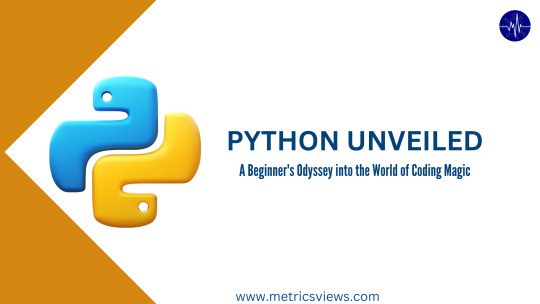
Installation:
Visit the official Python website: https://www.python.org/downloads/windows/
Click the appropriate link for your system to download the executable file: Windows installer (64-bit) or Windows installer (32-bit).
Run that downloaded executable installer file. For example, python.exe file.
Click Install to start the installation.
After the installation is complete, a Setup was successful message is displays.
To verify python installation:
Enter the code: python --version

Now you are ready to start learning and programming in Python.
Quick Summary:
Python has syntax that allows developers to write programs with less lines than some other programming languages. Python runs on an interpreter system. Python is a computer programming language often used to build websites and software, applications ,conduct data analysis.
Targeted Audience:
This article is intended for those people interested in learning the fundamentals of python development. It will be useful for freshers, backend developers, students. and for those who are lazy to write lengthy code because python has easy, simple syntax which includes short code.
Use Cases:
Web development -framework: Django, Flask, FastAPI, etc.
Data analysis - Pandas, NumPy
Game development - Pygame
Education and teaching programming concepts
Let’s see what Python is:
Definition:
Python is a high-level, general-purpose, interpreted object-oriented programming language and it is used to build websites and software.
Python code tends to be short and when compared to compiled languages like C and C++, it executes programs slower.
Features:
Easy to Learn and Use:
Python is easy to learn and simple as compared to other languages. Its syntax is straightforward.
There is no use of the semicolon or curly-bracket in syntax.
It is the most suggested programming language for beginners.
Interpreted Language:
Interpreted means program executes single line at a time.
The advantage of being interpreted language, makes it debugging easy and portable.
Expressive Language:
For Ex.: If you want to print small program you simply type print ("Hello World"). It will take only single line to execute, while Java or C takes multiple lines.
Free and Open Source:
Python is freely available for everyone. open-source means, "Anyone can download its source code without paying a single rupee.
Object-Oriented Language:
Python supports object-oriented language and concepts of classes and objects. It supports inheritance, polymorphism, and encapsulation, etc.
Syntax:
demo.py :- File name

How to run python file:
python myfile.py // here my myfile is name of program.

Python Comments:
Comments are often used to explain Python code. "#" used for commenting.
For Ex: # Printing hello world

Variables:
Variables are like containers it stores data values.
For Ex: x = 5 //x is a variable

Data Types:
String: In String datatype, we can store string values.

int: In int datatype, we can store int values.

float: In float datatype, we can store float values.

list: lists are always stored in square brackets [ ] .

tuple: tuples are always stored in round brackets ( ) .

dict: In Dictionaries, we store key value pair.

Function:
A function is a reusable block of code that performs some specific tasks. it only runs when it is called.
You can pass data, known as parameters in a function.
here : demo_function is function name. It can be anything.

Arrays:
Arrays are used to store multiple values but with same datatype.

To check length of an array
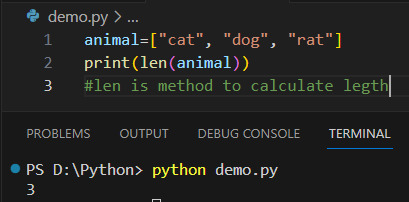
To add elements in array we use append method. For ex.: animal.append("fox")
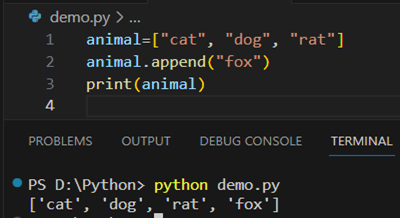
To delete elements in array we use pop method. it deleteindex wise.For Ex:animal.pop(1)
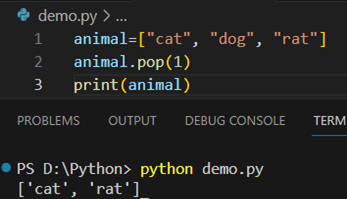
Removes all the elements from the list. Method:- clear()
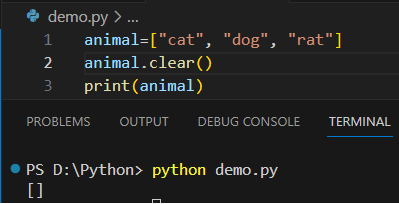
Returns the number of elements with the specific value. Method: count()
It will return index value of 4 that is 1.
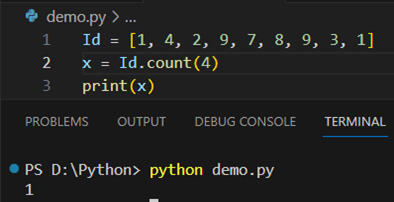
Adds an element at the specified position.Method:- insert()
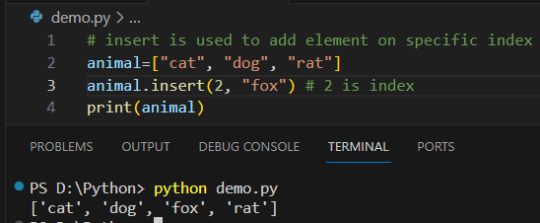
Removes the first item with the given value. Method: remove()

Reverses the order of the list. Method: reverse()
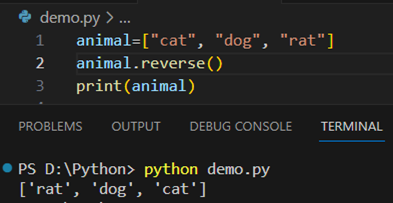
Sorts the list. Method: sort()
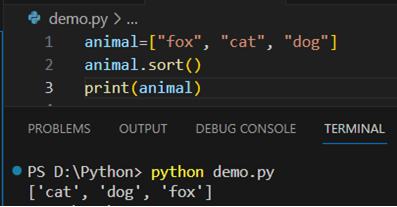
Class:
Class is a blueprint of an object.
It defines the structure and behavior of objects of that class.
The class keyword is used to define a class.
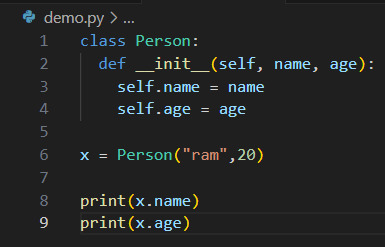
Object:
An object is an instance of a class and a collection of attributes and methods.
For ex.: x = Person("ram", 20)
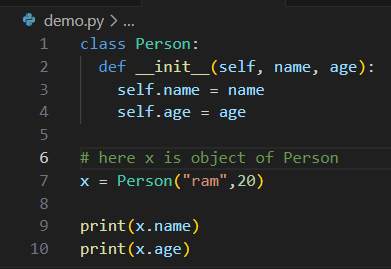
Inheritance:
Inheritance is a OOP concept that allows you to create a new class based on an existing class. The new class inherits attributes and methods from the existing class, which is referred to as the base or parent class. The newer class is called the derived or child class of the base class.
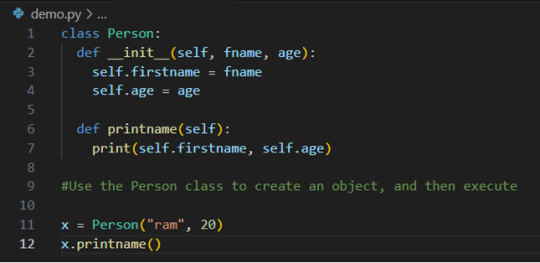
Polymorphism:
polymorphism means having many forms.
Method Overloading (Compile-Time Polymorphism):
having same name but different parameters.
Method Overriding (Run-Time Polymorphism):
having same name and same parameters.
Encapsulation:
simple lang. wrapping or hiding of data.
object has ability to hide data and behavior that is not necessary to use.
How to take User Input: For ex.
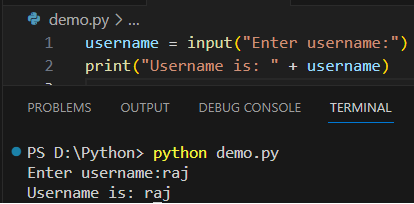
Closing Thought:
Python is a powerful and versatile programming language that has become an integral part of the technology. Everyone is using Python because of its simple syntax, and if you are a beginner, you should definitely go with python.
Credit – Priyanka Divekar
MetricsViews Pvt. Ltd.
MetricsViews specializes in building a solid DevOps strategy with cloud-native including AWS, GCP, Azure, Salesforce, and many more. We excel in microservice adoption, CI/CD, Orchestration, and Provisioning of Infrastructure - with Smart DevOps tools like Terraform, and CloudFormation on the cloud.
www.metricsviews.com.
0 notes
Text
11 Best Things to Do in Solo, Indonesia: A Symphony of Culture and Heritage

Solo, officially known as Surakarta, is a historic city located in Central Java, Indonesia. Often overshadowed by its more famous neighbor, Yogyakarta, Solo offers its unique blend of Javanese culture, heritage, and modernity.
For those keen on immersing themselves in authentic Javanese experiences, Solo is the place to be. Here are some top activities and sights that the city has to offer:
1. Visit the Kraton Surakarta
The heart and soul of Solo, the Kraton Surakarta, is the palace of the city's sultans. This sprawling complex is a living testament to Javanese royalty, with its magnificent architecture and cultural artifacts. While exploring the palace, you can witness traditional dance performances, learn about the history of the Mataram Kingdom, and get a glimpse of the life of Javanese royalty.
2. Stroll through Triwindu Antique Market
Step back in time at the Triwindu Antique Market, where a treasure trove of vintage items and antiques awaits. From ancient coins, traditional puppets, to vintage radios, each item tells a story of Java's rich past.
3. Experience the Batik Art
Solo is renowned for its traditional Batik art. Visit the Kampung Batik Laweyan, where the age-old tradition of batik-making is kept alive. You can watch artisans at work, learn about the intricate process of creating these beautiful fabrics, and even try your hand at making your own batik piece.
4. Relish Traditional Cuisine
Solo's culinary scene is a feast for the palate. Dive into local delicacies like "Nasi Liwet" (rice cooked in coconut milk and spices) and "Serabi Solo" (coconut milk pancakes). Don't forget to visit the legendary Warung Selat Mbak Lies, which has been serving its unique dish, Selat Solo, for decades.
5. Attend the Solo International Performing Arts (SIPA)
Held annually, SIPA attracts performers from around the world, showcasing a blend of traditional and contemporary arts. It's a vibrant celebration of music, dance, and theatre, held in various venues across the city.
6. Visit the House of Danar Hadi
A haven for batik enthusiasts, this place offers an extensive collection of both antique and contemporary batik designs. The attached museum provides insights into the history and evolution of batik art in Indonesia.
youtube
7. Witness the Bengawan Solo River
As Java's longest river, the Bengawan Solo holds historical and cultural significance. The riverbanks are perfect for evening strolls, where you can witness the local life and occasionally enjoy traditional performances.
8. Explore the Taman Sriwedari
Once a pleasure garden for the royal family, Taman Sriwedari is now a public space that encapsulates the cultural essence of Solo. It houses a traditional theater, where you can watch the famous Wayang Orang performances, a human version of the Javanese shadow puppet theatre. The park also boasts eateries serving local delicacies and a small amusement park for children.
9. Venture to Cetho Temple
Situated on the slopes of Mount Lawu, Cetho Temple stands as a testament to the ancient spiritual practices of the Javanese. This Hindu temple, with its intricate stone carvings and serene ambiance, offers not only spiritual enrichment but also panoramic views of the surrounding landscapes.
10. Shop at Pasar Klewer
No trip to Solo would be complete without visiting its bustling traditional market, Pasar Klewer. Known for its extensive collection of batik fabrics, from hand-painted designs to printed varieties, it's a shopper's paradise. Besides batik, you can also find an array of Javanese handicrafts, jewelry, and antiques.
11. Indulge in a Jamu Experience
'Jamu' is a traditional herbal medicine, integral to Javanese culture. In Solo, there are numerous 'Jamu' stalls and shops where you can taste these herbal concoctions, believed to have various health benefits. Some popular ones to try are 'Jamu Beras Kencur' and 'Jamu Kunir Asem.'
With its harmonious blend of tradition and modernity, Solo offers travelers an intimate look into the Javanese soul. The city, with its warm locals and rich cultural tapestry, ensures that every visitor leaves with cherished memories and a deeper appreciation for Java's heritage.
1 note
·
View note
Text

back to the basics [01]. instead of retyping already well-explained basics, i'll link free web-resources that'll explain everything well and with examples from w3.
resources: java resources via w3
but also some quick examples to get back into the flow:
//declaring and printing a string String name = "John"; System.out.println(name);
//declaring and printing an int (value) int myNum = 15; System.out.println(myNum);
//simple for loop for (int i = 0; i < 5; i++) { System.out.println(i); }
//declaring an int array int[] myNum = {10, 20, 30, 40};
this post is helpful to me, for quickly accessing resources on simple questions i might have regarding java syntax, simple operations and loops and such in the language.
0 notes
Text
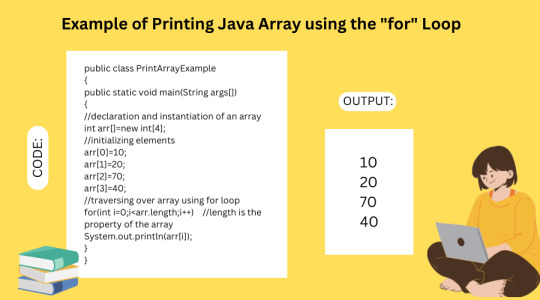
Example of Printing Java Array using the "for" Loop
Let us see an example of printing Java array using the "for" loop
#java#programming#javaprogramming#code#coding#engineering#software#softwaredevelopment#array#javaarray#arrayinjava#online#education#technology
2 notes
·
View notes
Text
The importance of C programming in today's technology landscape
Have you ever wondered how computer programs are made? Or perhaps you've heard of the "C" programming language. Today, numerous businesses still utilize C programming, which has been around for more than 50 years. This blog post will cover the importance of C programming in the current technological environment as well as the essential knowledge required to get started.
How does C programming work?
In the 1970s, Dennis Ritchie at Bell Labs developed the general-purpose, high-level programming language known as C. It is employed to produce software applications for a range of computer platforms, including desktop, server, and embedded systems. Because the C programming language is procedural, problems are solved step-by-step.
C programming is essential because it serves as the basis for many other programming languages, including Python, Java, and C++. You can pick up other languages with ease if you know how to program in C. Additionally, C programming is utilized in a wide range of products and fields, including operating systems, embedded systems, game development, machine learning, and web development.
For system-level programming, C is the best language since it is quick, effective, and powerful. Additionally, because it is a low-level language, programmers can precisely control how the hardware of the computer is used. Learning C can also help you obtain your dream career because many job postings in the technology sector want programming experience.
Applications of C Programming:
C programming is used in a wide range of applications, such as:
Operating systems :
The C programming language is used to develop operating systems, which are the fundamental component of all computer systems.
Embedded systems :
Embedded systems can be found in a wide range of items, including automobiles, medical devices, and consumer electronics, amongst others. C is the typical programming language used for these systems, which make use of microcontrollers.
Video games :
Video games are typically developed with the C programming language since the smooth running of these programs is dependent on code that is both quick and efficient.
Artificial intelligence (AI) :
C programming is used in the domains of artificial intelligence (AI) and machine learning. This allows these fields to design algorithms that are able to learn from data. In web development : In web development, the C programming language is used to write the code that is both rapid and effective. This code is required for web applications.
Coding in C Requires the Following Skills:
The following abilities are necessary to understand and use C programming:
Knowledge of algorithms and data structures: C programming calls for knowledge of how to solve problems using algorithms and data structures.
Knowing how to manage memory is essential for C programming in order to prevent errors and improve performance.
C programming involves knowledge of how the hardware of a computer operates and the ability to develop code that interacts with it. This is known as low-level programming.
Possessing the skills necessary to work with pointers and arrays is essential if you want to succeed with C programming.
Expertise in finding and repairing code faults is necessary when programming in C.
Conclusion:
Learning how to program in C is necessary for anyone who has even a passing interest in the information technology field. It serves as the basis for a great number of computer languages and is implemented in a wide range of different applications. A knowledge of algorithms and data structures, memory management, low-level programming, pointers and arrays, as well as the ability to debug, are all prerequisites for learning C programming. For anyone interested in learning C programming, there is a wealth of material available both online and in print. Because C programming is a skill that is in great demand, learning it can make it possible to apply for a wide variety of jobs in the field of information technology. If you are interested in programming and would like to learn a language that is both powerful and versatile, you should begin learning C programming as soon as possible.
Thank you for taking the time to read this blog on the importance of C programming in today's technology landscape. We hope that you found this information helpful and informative.
If you have any questions or would like to learn more about Shikuyaa's C programming course or other courses we offer, please visit our website or reach out to us on social media. You can find us on YouTube, Instagram, and LinkedIn. We would be happy to answer any questions you may have and help you get started on your programming journey.
Thank you again for reading, and we hope to see you soon at Shikuyaa!
#shikuyaa#Cprogramming#programminglanguages#technology#embedded systems#operatingsystems#datastructures#memorymanagement#lowlevelprogramming#pointers#arrays#debugging#algorithms#machinelearning#AI#webdevelopment#videogames#careeropportunities#Shikuyaa#onlinecourses#socialmedia
1 note
·
View note
Photo

Cannon: A Pittsburgh Titans Novel Sawyer Bennett Release Date: February 28, 2023
My GR Review: https://www.goodreads.com/review/show/5350876676?book_show_action=false
My Amazon Review: https://www.amazon.com/review/RCH3QGGOBS9KA/ref=pe_1098610_137716200_cm_rv_eml_rv0_rv

Synopsis:
Cannon West left his hockey playing days behind to care for his dying wife but has since found success on the other side of the bench. Now, as the youngest head coach in league history, he’s hoping to lead the Pittsburgh Titans to a winning season. The last thing he’s looking for is a relationship, but life sometimes takes us in another direction.
The Pittsburgh Titans are still working to move on from the tragic plane crash that forever changed the landscape of their organization. Having lost my wife, I know all about grief and the guilt of survival which makes me uniquely equipped to take this team to the next level. From the very first time I stepped inside the Titans’ arena, I knew I was exactly where I needed to be.
New to town, I’m still establishing my routine, but I have the most important aspect under control—the coffee shop where I stop on my way to the arena every morning. A strong cup of java and the gorgeous manager who I can’t help but chat up is quickly becoming my favorite way to start the day. But no matter how much I enjoy the blush that stains Ava Cavanaugh’s cheeks with my admittedly awkward attempt at flirting, I know it will never be more than brazen banter with a new friend. My job consumes almost all my time, and I know firsthand what that level of commitment can do to a relationship.
That doesn’t mean I’m not open to some fun. My career comes first, but Ava understands my boundaries. The only problem is that once I give into her temptation, the rules I set for myself become blurred, and my mixed signals hurt Ava—the one thing I promised I wouldn’t do. I’ve put myself in what seems to be an untenable situation, but I’ve faced those before. Now I need to find the strength to move past my fears, or risk losing my second chance at love with the woman who has stolen my heart.
All books in the Pittsburgh Titans series can be read as standalones. See the entire series here: https://sawyerbennett.com/bookstore/the-pittsburgh-titans-series/
Download Cannon: A Pittsburgh Titans Novel Amazon: https://amzn.to/3jIoTiV Nook: https://bit.ly/3xvyLER Apple: https://apple.co/3uHwGnB Google: https://bit.ly/3Ef1O0U Kobo: https://bit.ly/3JEJNdq Print: https://amzn.to/3mB5h1U
Audible (narrated by Stephen Dexter and Mackenzie Cartwright): http://bit.ly/3me3jYl
Buy the digital and signed paperback direct from Sawyer Bennett: https://bit.ly/STORE_Cannon ** Digital files will be delivered via BookFunnel and sent to the device of your choosing **

About the Author:
New York Times, USA Today, and Wall Street Journal Bestselling author Sawyer Bennett uses real life experience to create relatable stories that appeal to a wide array of readers. From contemporary romance, fantasy romance, and both women’s and general fiction, Sawyer writes something for just about everyone.
A former trial lawyer from North Carolina, when she is not bringing fiction to life, Sawyer is a chauffeur, stylist, chef, maid, and personal assistant to her very adorable daughter, as well as full-time servant to her wonderfully naughty dogs.
If you’d like to receive a notification when Sawyer releases a new book, sign up for her newsletter (sawyerbennett.com/signup).
Connect with Sawyer:
Facebook: http://bit.ly/Sawyer_FB Reader group: http://bit.ly/Sawyer_NEP
TikTok: https://bit.ly/Sawyer_TOK Instagram: http://bit.ly/Sawyer_IG
Website: www.sawyerbennett.com
Newsletter:
http://sawyerbennett.com/signup
Goodreads:
http://bit.ly/Sawyer_GR
0 notes
Text
Read and Print Array elements in java
public class TestArray{public static void main(String[] args) { double[] myList = {1.8, 2.9, 3.4, 3.5};// Print all the array elementsfor (int i = 0; i < myList.length; i++) {System.out.println(myList[i] + ” “);}// Summing all elements double total = 0;double total = 0;for (int i = 0; i < myList.length; i++) { total += myList[i];}System.out.println(“Total is ” + total); // Finding the largest…
View On WordPress
0 notes
Text
Variables y Tipos De Datos En Python Para Data Science

Requisitos para este tutorial tener instalado:
Python con Anaconda
Jupyter Notebook
Con Anaconda instalado y Jupyter notebook en funcionamiento, tenemos todo en su lugar para comenzar con Python
Variables
Una variable no es nada más que una espacio en la memoria, con un nombre asignado, donde se almacenan datos, o algún tipo de dato. Entonces cuando hablamos de asignar un valor a una variable significa que almacenaremos datos en una ubicación o espacio de la memoria con un nombre especifico. A diferencia de otros lenguajes de programación como C++, Java y C#, Python es flexible en su definición de variables, lo que significa que no tienen que definir el tipo de datos al crear una variable. Más bien, el tipo de los datos se evalúan en tiempo de ejecución.
Tipos De Datos
Los tipos de datos de un lenguaje de programación hacen referencia al tipo de datos que el el lenguaje mismo es capaz de procesar. Los siguientes son los principales tipos de datos usados en Python.
a. Cadenas
Definen cualquier cadena de texto y caracteres, siempre están entre comillas.
b. Enteros
Son cualquier valor númerico entero.
c. Flotantes
Valores de punto flotante o decimal.
d. Booleanos
Solo puede tomar valores de Verdadero y Falso.
e. Listas
Coleccionan cualquier dato, en otros lenguajes se les conoce como “arrays”. Para estructuras de datos en Python, es muy importante aprenderlas
f. Tuplas
Las tuplas son un tipo de datos de colección ordenado en Python, similar a las listas, pero a diferencia de las listas, éstas son inmutables, es decir, sus elementos no pueden ser cambiados ni desordenado
En el ejemplo siguiente se muestra cómo crear diferentes tipos de datos que ya hemos definido y cómo almacenarlos en una variable correspondiente. Noten que al final, el script también imprime el tipo de datos de las variables mediante la función type()
# Una variable cadena o string primer_apellido = "Rojas" print (type(primer_apellido)) # Una variable entero edad = 30 print (type(edad)) # Variable Flotante peso = 76.39 print (type(peso)) # Una variable booleana X = False Y = True print (type(X)) # Listas carros = ["Nissan" , "Toyota" , "Suzuki" ] print (type(carros)) # Tuplas dias = ("Domingo" , "Lunes" , "Martes" , "Miercoles" , "Jueves" , "Viernes" , "Sabado" ) print (type(dias))
Resultados:
<class ‘str’> <class ‘int’> <class ‘float’> <class ‘bool’> <class ‘list’> <class ‘tuple’>
Tipos de Operadores
Existen 5 tipos de operadores básicos en python, en este post aprenderemos para que sirven cada uno.
Operadores Aritmeticos Los operadores aritméticos se utilizan para realizar operaciones aritméticas en Python. En este nuevo post exploraremos los más usados. La siguiente tabla resume los operadores aritméticos compatibles con Python. Suponga que X = 4 e Y = 2.
NombreSimboloEjemploADICION+X + Y = 6SUBSTRACCION-X - Y = 2MULTIPLICACION*X * Y = 8DIVISION/X / Y = 2MODULO%X%Y = 0POTENCIACION**X**Y=16
Ahora un ejemplo de estos operadores aritmeticos puestos en el IDE.
X = 4 Y = 2 print (X + Y) print (X – Y) print (X * Y) print (X / Y) print (X ** Y)
Resultado
6 2 8 2.0 16 Operadores Lógicos Python tiene palabras clave especiales llamados operadores lógicos que se suelen usar a menudo con resultados booleanos (TRUE/FALSE). Hay tres operadores lógicos: AND, OR y NOT. A continuacion algunos ejemplos. AND: Si ambos son verdaderos, el resultado final es True
# Ambos son verdaderos 1 < 2 and 5 > 4 True
Si ambos son falsos, el resultado es False
# Ambos son Falsos 2 < 2 and 1 > 4 False
Si uno es verdadero, y el otro falso, el resultado es False
# Primero verdadero y el segundo falso 2 < 4 and 1 > 2 False
OR: Si ambos son verdaderos, el resultado final es True
# Ambos son verdaderos 1 < 2 or 5 > 4 True
Si ambos son falsos, el resultado es False
# Ambos son Falsos 2 < 2 or 3 > 6 False
Si uno es verdadero, y el otro falso, el resultado es True
# Primero verdadero y el segundo falso 2 < 4 or 1 > 2 True
NOT: Not reversa el valor real de una expresion True o False. Ejemplo
# Ejemplos not True False not False True
Operadores de comparación Como su nombre lo indica, se usan para comparar uno o mas operadores, dependiendo de la relacion que tengan, los operadores de comparacion arrojan resultados booleanos.
# Ejemplos X = 2 Y = 3 print (X == Y) print (X != Y) print (X > Y) print (X < Y) print (X >= Y) print (X <= Y)
resultados
False True False True False True
Operadores de Asignación Asignan valores a variables. Los valores se asignan a una variable mediante un símbolo especial llamado operador de asignación. En este caso el operador es un símbolo, como = o + o -, que realiza alguna operación en uno o más valores.
# Ejemplos # Asigna valores de la derecha (suma) a R X = 20; Y = 10 R = X + Y print (R) # Asigna el resultado de la suma al operador izquierdo X = 20; Y = 10 X += Y print (X) # Asigna el resultado de la resta al operador izquierdo X = 20; Y = 10 X -= Y print (X) # Asigna el resultado de la multiplicacion al operador izquierdo X = 20; Y = 10 X *= Y print (X) # Asigna el resultado de la division al operador izquierdo X = 20; Y = 10 X /= Y print (X) # Asigna el resultado del restante de la division al operador izquierdo X = 20; Y = 10 X %= Y print (X) # Asigna el resultado de potencia al operador izquierdo X = 20; Y = 10 X **= Y print (X)
Resultados
30 30 10 200 2.0 0 10240000000000
7 notes
·
View notes